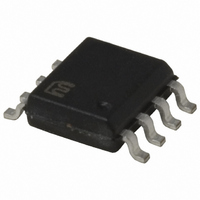MIC4452BM Micrel Inc, MIC4452BM Datasheet - Page 8

MIC4452BM
Manufacturer Part Number
MIC4452BM
Description
IC DRIVER MOSF 12A LO SIDE 8SOIC
Manufacturer
Micrel Inc
Specifications of MIC4452BM
Rise Time
20ns
Mounting Type
Surface Mount
Configuration
Low-Side
Input Type
Non-Inverting
Delay Time
15ns
Current - Peak
12A
Number Of Configurations
1
Number Of Outputs
1
Voltage - Supply
4.5 V ~ 18 V
Operating Temperature
-40°C ~ 85°C
Package / Case
8-SOIC (3.9mm Width)
Device Type
MOSFET
Driver Case Style
SOIC
No. Of Pins
8
Peak Output High Current, Ioh
12A
Supply Voltage Min
4.5V
Peak Reflow Compatible (260 C)
No
Number Of Drivers
1
Driver Configuration
Non-Inverting
Driver Type
Low Side
Input Logic Level
CMOS/TTL
Fall Time
50ns
Propagation Delay Time
60ns
Operating Supply Voltage (max)
18V
Peak Output Current
12mA
Power Dissipation
1.04W
Output Resistance
0.8Ohm
Operating Supply Voltage (min)
4.5V
Turn Off Delay Time
80fs
Turn On Delay Time (max)
40ps
Operating Temp Range
-40C to 85C
Operating Temperature Classification
Industrial
Mounting
Surface Mount
Pin Count
8
Package Type
SOIC
Lead Free Status / RoHS Status
Contains lead / RoHS non-compliant
High Side Voltage - Max (bootstrap)
-
Lead Free Status / RoHS Status
Not Compliant, Contains lead / RoHS non-compliant
MIC4451/4452
Input Stage
The input voltage level of the MIC4451 changes the quiescent
supply current. The N channel MOSFET input stage transistor
drives a 320µA current source load. With a logic “1” input, the
maximum quiescent supply current is 400µA. Logic “0” input
level signals reduce quiescent current to 80µA typical.
The MIC4451/4452 input is designed to provide 200mV of
hysteresis. This provides clean transitions, reduces noise
sensitivity, and minimizes output stage current spiking when
changing states. Input voltage threshold level is approximately
1.5V, making the device TTL compatible over the full tem-
perature and operating supply voltage ranges. Input current
is less than ±10µA.
The MIC4451 can be directly driven by the TL494,
SG1526/1527, SG1524, TSC170, MIC38C42, and similar
switch mode power supply integrated circuits. By offloading
the power-driving duties to the MIC4451/4452, the power
supply controller can operate at lower dissipation. This can
improve performance and reliability.
The input can be greater than the V
will flow into the input lead. The input currents can be as high
as 30mA p-p (6.4mA
to MIC4451/4452 however, and it will not latch.
The input appears as a 7pF capacitance and does not
change even if the input is driven from an AC source. While
the device will operate and no damage will occur up to 25V
below the negative rail, input current will increase up to
1mA/V due to the clamping action of the input, ESD diode,
and 1kΩ resistor.
Power Dissipation
CMOS circuits usually permit the user to ignore power dis-
sipation. Logic families such as 4000 and 74C have outputs
which can only supply a few milliamperes of current, and even
shorting outputs to ground will not force enough current to
destroy the device. The MIC4451/4452 on the other hand,
can source or sink several amperes and drive large capacitive
loads at high frequency. The package power dissipation limit
can easily be exceeded. Therefore, some attention should
be given to power dissipation when driving low impedance
loads and/or operating at high frequency.
MIC4451/4452
GROUND
GROUND
POWER
LOGIC
Figure 5. Switching Time Degradation Due to
0 V
5.0V
0.1µF
300 mV
+18
MIC4451
Negative Feedback
RMS
1
4
12 AMPS
) with the input. No damage will occur
8
5
PC TRACE RESISTANCE = 0.05Ω
6, 7
WIMA
MKS-2
1 µF
TEK CURRENT
0.1µF
PROBE 6302
S
supply, however, current
2,500 pF
POLYCARBONATE
18 V
0 V
8
The supply current vs. frequency and supply current vs ca-
pacitive load characteristic curves aid in determining power
dissipation calculations. Table 1 lists the maximum safe
operating frequency for several power supply voltages when
driving a 10,000pF load. More accurate power dissipation
figures can be obtained by summing the three dissipation
sources.
Given the power dissipation in the device, and the thermal
resistance of the package, junction operating temperature
for any ambient is easy to calculate. For example, the ther-
mal resistance of the 8-pin plastic DIP package, from the
data sheet, is 130°C/W. In a 25°C ambient, then, using a
maximum junction temperature of 125°C, this package will
dissipate 960mW.
Accurate power dissipation numbers can be obtained by sum-
ming the three sources of power dissipation in the device:
• Load Power Dissipation (P
• Quiescent power dissipation (P
• Transition power dissipation (P
Calculation of load power dissipation differs depending on
whether the load is capacitive, resistive or inductive.
Resistive Load Power Dissipation
Dissipation caused by a resistive load can be calculated
as:
where:
R
Capacitive Load Power Dissipation
Dissipation caused by a capacitive load is simply the energy
placed in, or removed from, the load capacitance by the
driver. The energy stored in a capacitor is described by the
equation:
Table 1: MIC4451 Maximum
Operating Frequency
Conditions:
D =
O
I =
=
the current drawn by the load
the output resistance of the driver when the output
is high, at the power supply voltage used. (See data
sheet)
fraction of time the load is conducting (duty cycle)
P
E = 1/2 C V
18V
15V
10V
5V
V
L
= I
S
2
R
1. θ
2. T
3. C
O
D
A
2
JA
L
= 25°C
= 10,000pF
= 150°C/W
L
)
Max Frequency
T
Q
)
)
220kHz
300kHz
640kHz
2MHz
Micrel, Inc.
July 2005











